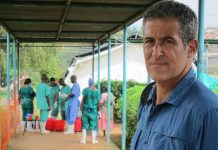
Essential workers must take the Covid vaccine first, according to a Centers for Disease Control and Prevention panel.
The panel voted 13-1 Sunday to have “frontline essential workers” and people 75 years of age and older prioritized for taking the coronavirus vaccine.
The phase 1b group is expected to include about 49 million people, or nearly 15% of Americans, according to the CDC’s Advisory Committee on Immunization Practices (ACIP). The committee is composed of frontline essential workers such as police officers, teachers, firefighters, corrections officers, and others but relegated “other essential workers” to phase 1c.
Educational staff, including daycare workers, manufacturing workers, food and agricultural workers, U.S. postal service employees, public transit workers, and grocery store workers are also part of the list, based on ACIP’s provided list. ACIP states that these workers “are in sectors essential to the functioning of society and are at substantially higher risk of exposure” to Covid.
“I would like to note that the persons 75 years and older represent 8% of the population, 25% of hospitalizations, and have a very high death rate. Frontline essential workers have high exposures. They include a disproportionate share of racial and ethnic persons who also have a disproportionate share of hospitalizations,” Dr. Katherine Poehling, a member of the committee, said after the vote.
Dr. Henry Bernstein of Northwell Cohen Children’s Medical Center, who voted against the proposal, pointed out that he is in favor of including those 65 years of age and older.
Phase 1c must cover persons between the ages of 65 and 74, people between the ages of 16 and 64 who have high-risk health issues and remaining essential workers, ACIP says. That is 129 million Americans or over one-third of the country, the panel adds.
The remaining essential workers include food service workers, construction workers, finance workers, transportation and logistics workers, IT and communications workers, energy workers, legal workers, media personnel, wastewater workers, and engineers, ACIP said. Meanwhile, underlying conditions for prioritization purposes include cancer, obesity, smoking, and more, per ACIP.
The committee’s proposal will be sent to CDC Director Dr. Robert Redfield, who usually accepts the committee’s recommendations. However, state officials have the final decision on distribution. The CDC previously recommended that states prioritize health-care workers and long-term care facility residents during the initial distribution of the vaccines.
Dr. Kathleen Dooling of CDC stressed that the order in which those groups are vaccinated does not completely influence the dynamics of the outbreak, based on the latest modeling.
“Differences between strategies is minimal,” she said. “Vaccinating older adults first averts slightly more deaths, while vaccinating younger adults first, essential workers and younger adults with high-risk conditions, averts slightly more infections.”
She furthered that the most critical factor is “actually the timing of the vaccine introduction related to increases in Covid-19 cases.” She noted people must practice social distancing and mask-wearing to minimize spread while scarce doses of vaccines are still being distributed.
“We are faced with the situation, at least in the short term, where we have a limited supply of vaccine available to us,” Dr. Nancy Messonnier, director of the CDC’s National Center for Immunization and Respiratory Diseases, said Sunday to open the all-day meeting. “What that means is that there will be difficult choices about who gets that vaccine first.”
The U.S. predicts being able to produce vaccine doses enough for 20 million people in December, 30 million in January, and 50 million in February, Messonnier said. Phase 1a covers at least 24 million people, phase 1b will add another 49 million people, and phase 1c will expand eligibility to another 129 million.
Dr. Jeff Duchin, public health officer of Seattle and King County, Washington, said that local public health departments that are turning vaccines in vaccinations must be funded.
“Resources are needed for public health vaccination clinics to ensure equitable access to vaccines across communities and populations,” he said. “There is a critical and immediate need for adequate funding and resources for vaccine program implementation.”
Dr. Christine Hahn of the Council of State and Territorial Epidemiologists believes that the most important thing is that the CDC gives enough guidance to avoid “paralysis by analysis” at the local level.
“There is no way we’re going to be able to all stay lockstep, and we need to message clearly that there’s going to be local decisions, because the worst thing that can happen is we leave vaccines in the freezer because we are afraid to move into that next group and keep going,” she said. “We have to have faith in our local public health officials and state health officials to do the right thing”






